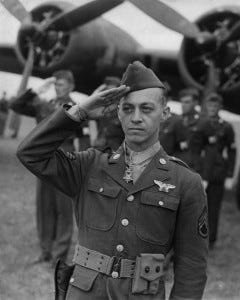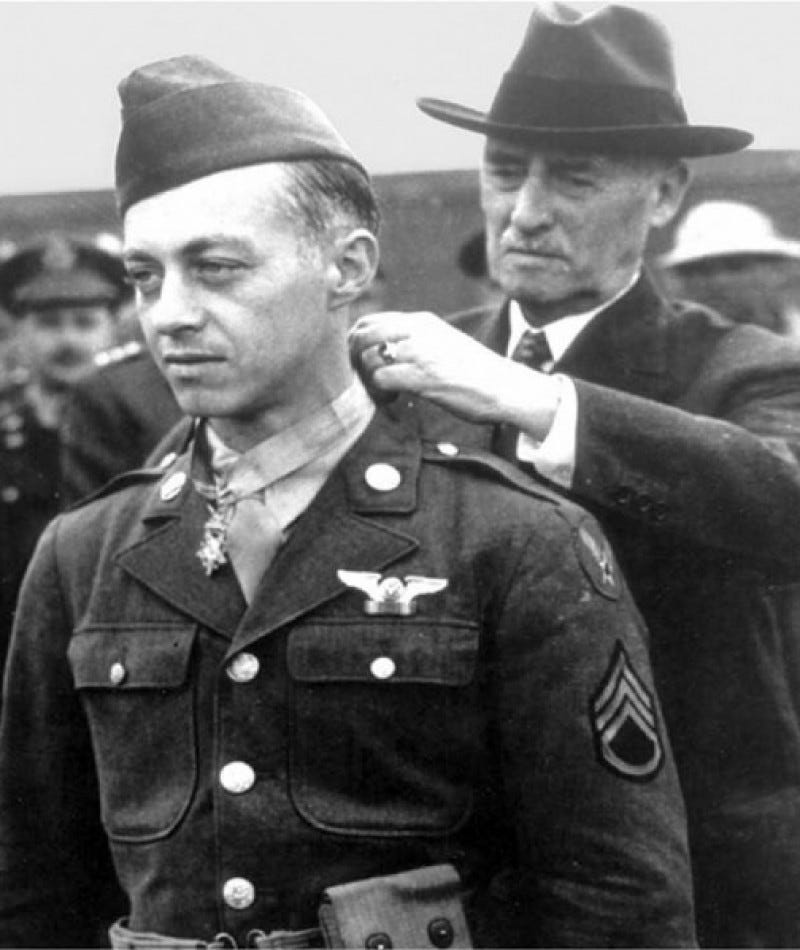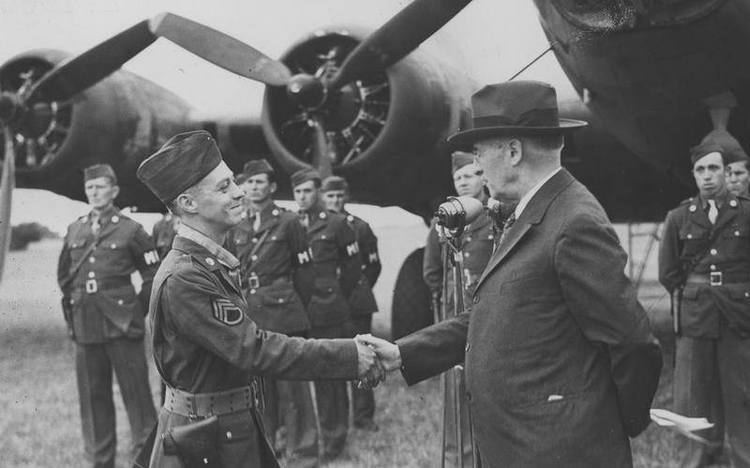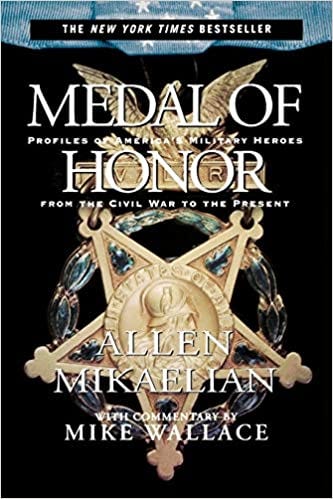“You Don't Have To Be A Saint To Be A Hero” - the incredible story of WWII B17 crew member and Medal of Honor recipient Maynard H. "Snuffy" Smith
Snuffy Smith was not happy about cramming his small frame into the clear Plexiglass ball turret in the belly of a B-17. Almost from the start, it seemed that the mission was doomed. Unknown to him at the time, the lead navigator had miscalculated the flight home and turned east too early. Instead of crossing the English coast, the flight was flying low over the northwest peninsula of France and directly into the German guns at Brest. The sky was suddenly filled with deadly accurate flak and from his position in the Plexiglas turret, Snuffy could see one of the other Flying Fortresses falling in a pall of smoke and fire.
Snuffy Smith watched the black puffs of smoke erupt around him more with amusement than fear. "First you hear a tremendous whoosh," he later candidly recalled, "then the bits of shrapnel patter against the sides of the turret, then you see the smoke."
Too late to climb high, pilot Lieutenant Johnson dropped rapidly beneath the flak just as the first enemy fighters pounced. In the distance, a string of 20mm cannon fire exploded in the B-17 named Vertigo which was piloted by Lt. Robert Rand of the 91st Bomb Squadron. Lieutenant Rand was instantly killed and co-pilot Major Maurice Rosener fought to control the quickly failing bomber. It was falling out of formation even as the first enemy rounds raked across the B-17 from which Snuffy was returning fire.
"The slugs came all around us," recalled Lieutenant McCallum. "The whole ship shook and kind of bonged like a sound effect in a Walt Disney movie."
The stricken B-17's gunners opened up to repel the onslaught. In the ball turret, Snuffy remained unusually alert for a man on his first mission and facing his baptism of fire. "I was watching the tracers from a Jerry fighter come puffing by our tail, when suddenly there was a terrific explosion," he later told reporter Andy Rooney. "Whoomp, just like that. Boy, it was a pip," he said of the hit that ruptured the gas tanks and set the midsection ablaze. In the span of a few minutes, the pilot's earlier joke about ditching the plane on his last mission so he would have an exciting war story to tell his children had come shockingly true.
In the ball turret, Snuffy Smith was acutely aware that his intercom was out and his ball turret housing dual 50 caliber guns was worthless. He hand-cranked himself up to the interior fuselage and extracted his small body to find a massive fire in the radio room ahead of him - another in the tail section behind. As an admitted agnostic since his youth, Snuffy had scoffed at the concept of Hell. Now he found himself in the middle of Hell on Earth!
"He (Bean) made a beeline for the gun hatch and dove out. Dove right out.” He jumped high, and failed to clear the horizontal stabilizer. “He must have broken into a dozen pieces,” Smith surmised, but his parachute opened, allowing him a soft landing in the frigid English Channel, where he presumably drowned.
The bomber's veteran waist gunners, Sergeants Joseph Bukackek and Robert Folliard had reached the same conclusion as Sergeant Bean. One had already jumped, the other was hung up half-in and half-out of the gun hatch. "I pulled him back in and asked him if the heat was too much for him," Snuffy continue. "All he did was stare at me and say 'I'm getting out of here.' I helped him open the rear escape door and watched him bale out. His 'chute opened okay."
With the three veteran waist gunners floating earthward into the waters of the English Channel where they disappeared for eternity, Snuffy was alone in the blazing inferno. The fate of bomber 42-29649 was now in the hands of the untested airman who had a reputation for being a total screw-up. In his 32 years of life, Maynard Smith had never made a serious decision or accomplished anything to be proud of. What he did in the next 90 minutes of unprecedented crisis above the English Channel was nothing short of remarkable.
"The smoke and gas were really thick. I wrapped a sweater around my face so I could breathe, grabbed a fire extinguisher, and attacked the fire in the radio room. Glancing over my shoulder at the tail fire, I thought I saw something coming, and I ran back. It was (Sergeant Roy H.) Gibson, the tail gunner, painfully crawling back, wounded. He had blood all over him."
Snuffy dragged Sergeant Gibson away from the flames and quickly examined him. The tail gunner had been shot in the back; his left lung pierced. Snuffy rolled the wounded man onto his left side, wounded side down, to keep blood from filling the right lung and gave him a shot of morphine. Then he returned to try and fight the fires.
Enemy fighters had not yet given up on the floundering bomber and suddenly, Smith saw a Focke Wulf 190 lining up for another deadly pass. Snuffy dropped his fire extinguisher and bounded towards one of the waist guns to return fire. As the enemy fighter passed beneath the burning bomber, Snuffy switched to the waist gun at the other side to deliver a parting series of 50-caliber rounds. Then it was back to fighting fires once again.
Forcing his way into the radio room, where the fire was heaviest, he noticed that the intense heat had burned gaping holes through the fuselage. Through these openings, he began tossing the flaming debris to clear the area and deny more fuel to the fire. When ammunition boxes began to explode from the heat he tossed those out as well.
At this point, he found his parachute too cumbersome, so he tossed it aside. “I was glad I hadn’t taken it off sooner,” he remarked later, “ because I found a fifty-caliber bullet halfway through it. It would have gone all the way through me.”
All the while enemy fighters continued their menacing attack.
"I fired another burst with the waist guns and went back to the radio room with the last of the extinguisher fluid. When that ran out, I found a water-bottle and a urine cane and used those. After that I was so mad, I urinated on the fire and finally beat on it with my hands and feet until my flight uniform began to smolder."
For an hour-and-a-half, the Sad Sack of the 423rd bomb Squadron single-handedly fought off enemy fighters, tended a seriously wounded comrade, and extinguished the flames that melted steel and metal to nearly severe the bomber. "To me, it was a dream," Snuffy later proclaimed. "I had just done what I had been trained to do. I didn't know what the hell it was all about. I wasn't there to get a medal. Like millions of others, I just wanted to get it over with and get home."
He also noted, "It was a miracle that the ship didn't break in two in the air, and I wish I could shake hands personally with the people who built her. They sure did a wonderful job, and we owe our lives to them."
In fact, B-17 #42-29649 did break in two. After reaching the English coast, Lieutenant Johnson gently nursed his bomber to the first available airfield at Predannack, Cornwall. As he put the tail wheel down on the runway the stress finished the job begun by enemy fire 90 minutes earlier, and the charred remains of the Flying Fortress skidded to a halt in two sections.
There were more than 3,500 bullet and shrapnel holes in the remains of Lieutenant Johnson's bomber. One propeller was shattered, the flaps were destroyed by enemy fire, the radio room gutted by fire, the left wing's gas tank destroyed, and the nose was shattered from flak. All that was salvaged were the engines and the lives of six men. Lieutenant Johnson was quick to credit his rookie gunner stating Smith had performed "acts which, by the will of God alone, did not cost him his life, performed in complete self-sacrifice and the utmost efficiency and which were solely responsible for the return of the aircraft and the lives of everyone aboard."

Lieutenant Johnson promptly recommended his heroic gunner for the Medal of Honor. In the six-week period before it was approved and presented, Snuffy Smith flew four more missions and received the first of two Air Medals. he also missed at least one mission he should have flown. Returning from town late after a pass, he missed a briefing and another gunner had to be found to fly a mission for which Smith had been scheduled. It was for this infraction that Snuffy had been punished with a week of KP, the duty with which he found himself occupied when Secretary of War Stimson came to England to present him with the Medal of Honor.
General Ira weaker announced, "Sergeant Smith not only performed his duty, he carried on after others - more experienced than he - had given up. Through his presence of mind, determination, and bravery, he saved the lives of six of his crew mates and the Fortress in which he flew."
Secretary of War Stimson stepped forward to place the Medal of Honor around Snuffy's neck while Generals saluted the diminutive and unlikely hero. Radio stations across the United States broadcast the events and listeners waited for the moment that the hero would speak himself. When that moment came, Snuffy Smith stepped to the microphone to simply say "Thank you" - nothing more.

When the ceremony concluded, the reporters pressed forward for a more substantial quote for their stories. One asked, "Isn't meeting the secretary of war and facing all the reporters' questions worse than the experience you had putting out the fire on board the Flying Fortress?” Snuffy simply answered, "No!"
In short order, all of America fell in love with the diminutive hero who had demonstrated that valor and greatness can be found in the most unlikely of characters.

As the first enlisted airman in history to earn the Medal of Honor, and the first living airman of the European theater to receive the award, Snuffy Smith became legendary. The legend became far greater than the man, for if indeed Sergeant Maynard H. Smith became living proof that you don't have to be a saint to become a hero, his actions beyond those 90 minutes in a burning B-17 proved that becoming a hero doesn't make you a saint! But that’s a story for another time…
* * *
Story from:https://homeofheroes.com/heroes-stories/world-war-ii/maynard-h-smith/
More:
- https://en.wikipedia.org/wiki/Maynard_Harrison_Smith
- https://www.cmohs.org/recipients/maynard-h-smith-sr
- https://www.mightyeighth.org/medal-of-honor-ssg-maynard-snuffy-smith/
* * *
★ THINK ★
What do the words “You don’t have to be a saint to be a hero” mean to you? Do you make excuses for yourself because of a past mistake? Are you letting your past control your future?
★ ACT ★
Leave the past where it belongs - in the past. Maybe you won’t singlehandedly save your whole plane from a fire and enemy fighters today, but what would it look like to “carry on after others have given up” with the humility that Snuffy showed - “I wasn’t there to get a medal”? Now go do it and share with us in The Brotherhood.
* * *
Get Some
Grab the book with this and many more harrowing stories of heroic acts of courage and sacrifice.

And another book all about one unlikely hero Snuffy…

How about this sweet vintage graphic T?

And get that new WWII leather bomber jacket smell anytime, anywhere (even in your cubicle cockpit) with these scented wax cubes that smell like victory wrapped in leather…

And here’s a pretty sweet vintage style tactical flight bag with top secret compartments for your gear…

* * *
Share The Cadre
⚔️ No one fights alone - join the Brotherhood here.
👉 Tell a friend and earn sweet swag
🎖 Got something shareworthy for the heroes? Share your story at jointhecadre.com
